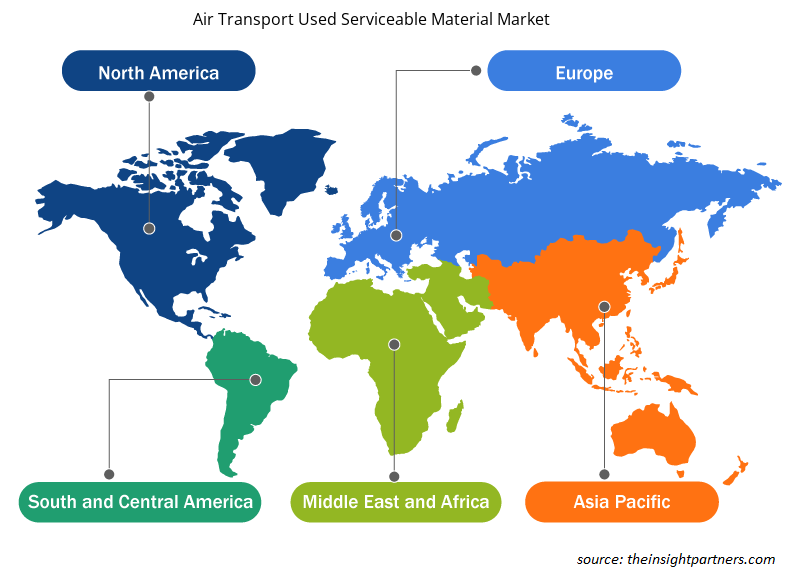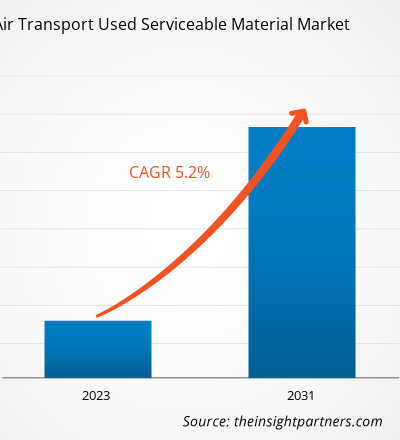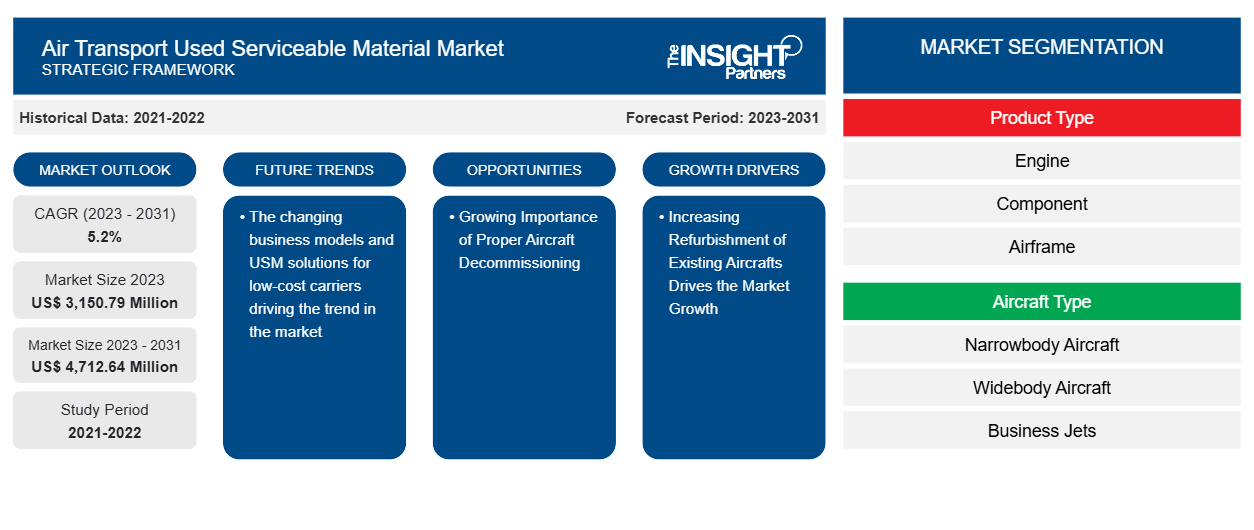Si prevede che il mercato dei materiali utilizzabili per il trasporto aereo raggiungerà i 4.712,64 milioni di dollari entro il 2031, rispetto ai 3.150,79 milioni di dollari del 2023. Si prevede che il mercato registrerà un CAGR del 5,2% nel periodo 2023-2031. I modelli di business in evoluzione e le soluzioni USM per i vettori low cost stanno guidando la tendenza del mercato. Le operazioni e i modelli di business delle aziende MRO stanno cambiando rapidamente, il che è, a sua volta, guidato da fattori quali la concorrenza spietata e le dinamiche globali in continua evoluzione. La crescente concorrenza tra le aziende, unita all'evoluzione delle flotte aeree e ai nuovi entranti nel settore dell'aviazione, ha minacciato la sostenibilità delle aziende MRO, spingendo così gli operatori a cercare modelli di business innovativi.
Analisi del mercato dei materiali riutilizzabili utilizzati nel trasporto aereo
Il settore dell'aviazione sta assistendo costantemente a diversi cambiamenti significativi in termini di tecnologia di produzione, tecnologia MRO e tendenze di approvvigionamento di aeromobili. Le compagnie aeree civili, i proprietari di jet aziendali e le compagnie aeree regionali stanno beneficiando massicciamente del calo dei costi del carburante per turbine aeronautiche negli ultimi anni. D'altro canto, i produttori di motori stanno enfatizzando e capitalizzando pesantemente la produzione di motori aeronautici a lunga durata. La lunga durata dei motori aeronautici sta portando alla compressione della catena di fornitura aftermarket nel settore dei motori aeronautici. Analogamente, il calo dei costi del carburante per turbine aeronautiche sta facilitando i proprietari di aeromobili a mantenere la loro flotta esistente per un periodo più lungo, il che si traduce in un minor tempo di smontaggio per gli aeromobili. I due fattori stanno influenzando positivamente la crescita del trasporto aereo utilizzando materiali riparabili.
Panoramica del mercato dei materiali riutilizzabili usati nel trasporto aereo
Il materiale riparabile per il trasporto aereo (USM) viene utilizzato su tutti e quattro i tipi di aeromobili durante i guasti di servizio di alcuni dei principali componenti dell'aeromobile . L'USM garantisce tempi di installazione del prodotto più rapidi e a costi inferiori. Il trasporto aereo utilizza materiali riparabili ed è utilizzato principalmente negli aeromobili a fusoliera stretta. Gli aeromobili a fusoliera stretta possono essere piccoli quanto un singolo sedile su entrambi i lati del corridoio e la variante più comune degli aerei a fusoliera stretta comprende tre sedili su entrambi i lati del corridoio. Boeing 737 Airbus A318/319/320/321 sono alcuni dei modelli di jet a fusoliera stretta più popolari. Tutti i principali produttori di aeromobili sono impegnati nella produzione di aeromobili a fusoliera stretta e Boeing, Airbus, Bombardier, Embraer e Tupolev, tra gli altri, sono alcuni dei principali OEM di aeromobili che producono aeromobili a fusoliera stretta in tutto il mondo. Questo fattore è uno dei principali fattori trainanti per il crescente utilizzo di USM negli aeromobili a fusoliera stretta a livello globale.
Personalizza questo report in base alle tue esigenze
Riceverai la personalizzazione gratuita di qualsiasi report, comprese parti di questo report, o analisi a livello nazionale, pacchetto dati Excel, oltre a usufruire di grandi offerte e sconti per start-up e università
-
Scopri le principali tendenze di mercato in questo rapporto.Questo campione GRATUITO includerà analisi di dati che spaziano dalle tendenze di mercato alle stime e alle previsioni.
Trasporto aereo: fattori trainanti e opportunità del mercato dei materiali utilizzabili
L'aumento della ristrutturazione degli aeromobili esistenti stimola la crescita del mercato
Lo spazio aereo globale sta vivendo un'enorme domanda di viaggi aerei in termini di aeromobili commerciali . Ciò sta portando le compagnie aeree e le forze di difesa a mantenere le loro flotte pronte con le ultime tecnologie e ad assicurare che siano integrati componenti robusti. La ristrutturazione degli aeromobili commerciali esistenti è una delle principali tendenze prevalenti nel settore dell'aviazione al momento. Si prevede che la tendenza aumenterà nel periodo, portando a grandi opportunità per i fornitori di componenti aeronautici e le aziende di manutenzione, riparazione e revisione (MRO). La ristrutturazione degli aeromobili include motori, carrelli di atterraggio, radar e antenne, tra gli altri. I fornitori di USM garantiscono la disponibilità di alcuni dei principali componenti aeronautici a costi inferiori e maggiore affidabilità, il che sta aumentando l'interesse tra i produttori di aeromobili. Pertanto, tali programmi guidano la domanda di USM per il trasporto aereo poiché si tratta di alternative a basso costo disponibili sul mercato.
Crescente importanza della corretta dismissione degli aeromobili
Secondo i dati IATA, negli ultimi 35 anni sono stati dismessi più di 15.000 aerei commerciali in tutto il mondo. Circa 700 aerei commerciali raggiungono la fine della loro vita operativa in media ogni anno. Vari fattori economici hanno portato al pensionamento anticipato degli aerei di oggi, dove il ciclo di vita medio di un aereo varia solitamente tra 20 e 36 anni. La dismissione degli aerei è diventata un processo vitale che deve essere gestito in modo efficiente per evitare qualsiasi rischio ambientale e di sicurezza.
Analisi della segmentazione del rapporto di mercato dei materiali riutilizzabili utilizzati nel trasporto aereo
I segmenti chiave che hanno contribuito alla derivazione dell'analisi del mercato dei materiali utilizzabili nel trasporto aereo sono il tipo di prodotto, il tipo di aeromobile, il fornitore e l'area geografica.
- In base al tipo di prodotto, il mercato è suddiviso in motori, componenti aeronautici e cellule. Tra questi, il motore ha la quota maggiore nel 2023. Ciò è dovuto alla crescente domanda di sostituzione dei componenti aeronautici. La crescente domanda di componenti aerei in surplus ha svolto un ruolo importante nel rimodellare le strategie aftermarket delle compagnie aeree. Il passaggio verso accordi di potenza oraria non motore e altri accordi di livello di servizio garantito conferisce a USM un ruolo più importante, il che aumenta la domanda di parti.
- In base al tipo di aeromobile, il mercato è suddiviso in aeromobili a fusoliera stretta, aeromobili a fusoliera larga, jet aziendali e jet regionali. Tra i tipi di aeromobile, gli aeromobili a fusoliera stretta sono i maggiori utilizzatori di USM a causa del loro elevato numero di flotte operative.
- A seconda del fornitore, il mercato è diviso in OEM e Non-OEM. Tra questi, si prevede che OEM avrà la quota maggiore nel 2023.
Analisi della quota di mercato dei materiali utilizzabili nel trasporto aereo per area geografica
L'ambito geografico del rapporto sul mercato dei materiali riutilizzabili utilizzati nel trasporto aereo è suddiviso principalmente in cinque regioni: Nord America, Asia Pacifico, Europa, Medio Oriente e Africa, e Sud e Centro America.
Si prevede che il Nord America dominerà il mercato globale dei materiali di servizio usati per il trasporto aereo durante il periodo di previsione, grazie alla presenza di diversi produttori leader di aeromobili. I principali attori chiave includono Boeing, Airbus Helicopters, Gulfstream Aerospace, Lockheed Martin, Piper Aircraft, Bye Aerospace, Cirrus, Dassault Aviation e altri. Il mercato dei materiali di servizio usati per il trasporto aereo nordamericano viene analizzato in base a diverse tendenze che si verificano nel settore dell'aviazione statunitense, canadese e messicana. Il settore dell'aviazione nordamericano assiste costantemente a progressi tecnologici in termini di cellula, motori, avionica, interni e altri componenti. La domanda in continua crescita di viaggi aerei spinge continuamente gli OEM di aeromobili a fornire aeromobili altamente tecnologici, mentre le aziende MRO stanno riscontrando una domanda significativa di servizi MRO rapidi.
Nell'attuale scenario di mercato, il calo dei prezzi del carburante per turbine aeronautiche ha avuto un impatto positivo sulla crescita delle flotte di aeromobili e sui viaggi in Nord America. Il calo dei prezzi del carburante, unito al ritardo nelle consegne degli aeromobili, ha portato le compagnie aeree o gli utenti finali degli aeromobili a mantenere la flotta di aeromobili esistente per un periodo prolungato. Ciò ha portato a un lento tasso di ritiro degli aeromobili.
Approfondimenti regionali sul mercato dei materiali riutilizzabili utilizzati nel trasporto aereo
Le tendenze regionali e i fattori che influenzano il mercato dei materiali di servizio usati per il trasporto aereo durante il periodo di previsione sono stati ampiamente spiegati dagli analisti di Insight Partners. Questa sezione discute anche i segmenti e la geografia del mercato dei materiali di servizio usati per il trasporto aereo in Nord America, Europa, Asia Pacifico, Medio Oriente e Africa e America centrale e meridionale.

- Ottieni i dati specifici regionali per il mercato dei materiali utili utilizzati nel trasporto aereo
Ambito del rapporto sul mercato dei materiali riutilizzabili utilizzati nel trasporto aereo
| Attributo del report | Dettagli |
|---|---|
| Dimensioni del mercato nel 2023 | 3.150,79 milioni di dollari USA |
| Dimensioni del mercato entro il 2031 | 4.712,64 milioni di dollari USA |
| CAGR globale (2023-2031) | 5,2% |
| Dati storici | 2021-2022 |
| Periodo di previsione | 2023-2031 |
| Segmenti coperti |
Per tipo di prodotto
|
| Regioni e Paesi coperti |
America del Nord
|
| Leader di mercato e profili aziendali chiave |
|
Trasporto aereo utilizzato materiale utilizzabile Mercato degli operatori Densità: comprendere il suo impatto sulle dinamiche aziendali
Il mercato del mercato dei materiali di servizio usati per il trasporto aereo sta crescendo rapidamente, spinto dalla crescente domanda degli utenti finali dovuta a fattori quali l'evoluzione delle preferenze dei consumatori, i progressi tecnologici e una maggiore consapevolezza dei vantaggi del prodotto. Con l'aumento della domanda, le aziende stanno ampliando le loro offerte, innovando per soddisfare le esigenze dei consumatori e capitalizzando sulle tendenze emergenti, il che alimenta ulteriormente la crescita del mercato.
La densità degli operatori di mercato si riferisce alla distribuzione di aziende o società che operano in un particolare mercato o settore. Indica quanti concorrenti (operatori di mercato) sono presenti in un dato spazio di mercato in relazione alle sue dimensioni o al valore di mercato totale.
Le principali aziende che operano nel mercato dei materiali riutilizzabili usati per il trasporto aereo sono:
- AJ Walter Aviation Limited
- Società AAR
- AFI KLM e E&M
- Servizi di materiali Delta
- Telefonia GA
- Società a responsabilità limitata
Disclaimer : le aziende elencate sopra non sono classificate secondo un ordine particolare.

- Ottieni la panoramica dei principali attori del mercato dei materiali di consumo usati per il trasporto aereo
Trasporto aereo Usato Materiale Riparabile Mercato Notizie e Sviluppi Recenti
Il mercato dei materiali di servizio usati per il trasporto aereo viene valutato raccogliendo dati qualitativi e quantitativi dopo la ricerca primaria e secondaria, che include importanti pubblicazioni aziendali, dati associativi e database. Di seguito sono elencati alcuni degli sviluppi nel mercato dei materiali di servizio usati per il trasporto aereo:
- Block Aero e Aircraft Fleet Recycling Association (AFRA) sono lieti di annunciare il lancio di una soluzione di conformità all'aeronavigabilità "Registry-as-a-Service" per parti serializzate. Questa iniziativa migliorerà la sicurezza, l'efficienza e la tracciabilità della gestione delle parti di aeromobili. Questa partnership strategica sfrutta la piattaforma blockchain per l'aviazione all'avanguardia di Block Aero per implementare una soluzione di database all'avanguardia. Il registro è progettato per soddisfare i requisiti delle autorità dell'aviazione civile per la gestione delle informazioni e la divulgazione pubblica delle parti di aeromobili riutilizzate nell'aftermarket dell'aviazione. (Fonte: sito Web aziendale, marzo 2024)
Copertura e risultati del rapporto sul mercato dei materiali utilizzabili nel trasporto aereo
Il rapporto "Dimensioni e previsioni del mercato dei materiali utili utilizzati nel trasporto aereo (2021-2031)" fornisce un'analisi dettagliata del mercato che copre le seguenti aree:
- Dimensioni e previsioni del mercato dei materiali utili utilizzati nel trasporto aereo a livello globale, regionale e nazionale per tutti i segmenti di mercato chiave coperti dall'ambito
- Il trasporto aereo ha utilizzato le tendenze del mercato dei materiali utilizzabili, nonché le dinamiche di mercato quali conducenti, limitazioni e opportunità chiave.
- Analisi PEST e SWOT dettagliate
- Analisi del mercato dei materiali utili utilizzati nel trasporto aereo che copre le principali tendenze del mercato, il quadro globale e regionale, i principali attori, le normative e i recenti sviluppi del mercato
- Analisi del panorama industriale e della concorrenza che comprende la concentrazione del mercato, l'analisi delle mappe di calore, i principali attori e gli sviluppi recenti per il mercato dei materiali riutilizzabili utilizzati nel trasporto aereo.
- Profili aziendali dettagliati
- Analisi storica (2 anni), anno base, previsione (7 anni) con CAGR
- Analisi PEST e SWOT
- Valore/volume delle dimensioni del mercato - Globale, Regionale, Nazionale
- Industria e panorama competitivo
- Set di dati Excel
Report recenti
Testimonianze
Motivo dell'acquisto
- Processo decisionale informato
- Comprensione delle dinamiche di mercato
- Analisi competitiva
- Analisi dei clienti
- Previsioni di mercato
- Mitigazione del rischio
- Pianificazione strategica
- Giustificazione degli investimenti
- Identificazione dei mercati emergenti
- Miglioramento delle strategie di marketing
- Aumento dell'efficienza operativa
- Allineamento alle tendenze normative























 Ottieni un campione gratuito per - Mercato dei materiali riutilizzabili usati nel trasporto aereo
Ottieni un campione gratuito per - Mercato dei materiali riutilizzabili usati nel trasporto aereo